Strong support for Europeana from Neelie Kroes
November 10, 2010 9:27 AM
Neelie Kroes, European Commission Vice-President for the Digital Agenda, says Europeana can be a world leader, if it is able to share the full wealth of written and multi-media material held in cultural institutions across Europe.
The comments came during a recent speech at the Forum d'Avignon, an international meeting for culture, economy and media.
"What a digital wonder this is: a single access point for cultural treasures that would otherwise be difficult to access, hidden or even forgotten," said Kroes about Europeana. She also stressed the importance of Europeana being able to display more 20th century materials, including orphan works and out-of- distribution works.
Neelie Kroes European Commission Vice-President for the Digital Agenda A digital world of opportunities Forum d'Avignon - Les rencontres internationales de la culture, de l'économie et des médias Avignon, 5th November 2010.
Read the speech
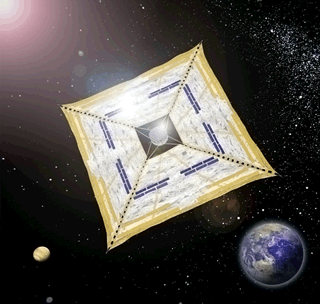 Japan launches Venus orbiter and solar sail experiment Japan launches Venus orbiter and solar sail experiment
By Physics Today on May 21, 2010 9:32 AM
Physics Today: The Japan Aerospace Exploration Agency yesterday launched two scientific spacecraft aboard a single H-IIA rocket.
The 640-kg Akatsuki (“daybreak”) is now on its way to a rendezvous with Venus in late December or early January. From its orbit around the planet, the spacecraft’s suite of instruments will study lightning, volcanism, and other active Venusian processes. The objective of the rocket’s other payload, the 300-kg
IKAROS (Interplanetary Kite-craft Accelerated by Radiation Of the Sun), is to assess the feasibility of propelling spacecraft solely with solar energy. In a few weeks’ time, IKAROS (depicted at right) will unfurl a 14 × 14 m2 sail that will harvest the momentum of solar photons. Embedded in the sail are thin solar cells that will power the spacecraft’s electronics and drive a second means of locomotion and maneuver: an ion propulsion engine.
 
Japan to Launch Mission to Venus and Solar Sail on Monday
The Planetary Society Is Mission Participant
Pasadena, CA, — Japan's AKATSUKI mission -- the Venus Climate Orbiter -- will launch Monday, May 17 along with the IKAROS solar sail. Flying aboard both spacecraft are the names of The Planetary Society's members as well as greetings from others who signed up to send their names and messages to Venus.
AKATSUKI -- which means "dawn" -- is designed to explore the atmosphere of Venus, and its scientific instruments include cameras that will study the planet in wavelengths from ultraviolet to the mid-infrared. The mission's goal is to help answer the question of how Venus and Earth, sister worlds in size and composition, evolved into such different planets.
The second mission's name, IKAROS, stands for Interplanetary Kite-craft Accelerated by Radiation Of the Sun. It is a solar sail that is designed to employ both photon propulsion and thin film solar power generation during its interplanetary cruise. Read more...
IKAROS vor dem Start
Die Japanische Raumfahrtbehörde JAXA will mit der Raumsonde IKAROS demonstrieren, dass man Sonnensegel bei Tiefraummissionen für Antrieb und Energiegewinnung einsetzen kann.
 IKAROS (Interplanetary Kite-craft Accelerated by Radiation Of the Sun) soll gemeinsam mit Akatsuki, einer Sonde zur Erforschung des Klimas auf der Venus, Mitte Mai mit einer HII-A-Trägerrakete auf den Weg gebracht werden. Während Akatsuki (auch Planet C oder Venus Climate Orbiter) Kurs auf unseren inneren Nachbarplaneten nimmt, wird Ikaros auf eine Bahn ins innere Sonnensystem entlassen. IKAROS (Interplanetary Kite-craft Accelerated by Radiation Of the Sun) soll gemeinsam mit Akatsuki, einer Sonde zur Erforschung des Klimas auf der Venus, Mitte Mai mit einer HII-A-Trägerrakete auf den Weg gebracht werden. Während Akatsuki (auch Planet C oder Venus Climate Orbiter) Kurs auf unseren inneren Nachbarplaneten nimmt, wird Ikaros auf eine Bahn ins innere Sonnensystem entlassen.
Hier soll ein quadratisches Sonnesegel mit einer Diagonale von 20 Metern durch Rotation entfaltet werden. Dabei ist geplant, dass vier Massestücke, die an den Ecken der Folie befestigt sind, diese straff ziehen. Auf einem Teil der Kunststoffmembran mit einer Dicke von nur 7,5 Mikrometern (0,0075 mm) sind Dünnschichtsolarzellen aufgedruckt, welche die Energie zum Betrieb des neuartigen Raumfahrzeugs liefern sollen. Weiterlesen
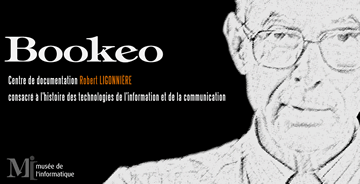 Longévité de l'information numérique Longévité de l'information numérique
Les données que nous voulons garder vont-elles s'effacer ?
2010 - EDP Sciences - 978-2-7598-0509-9 - 106 pages - FR
"Perché concentrarsi sulla conservazione a lungo termine delle informazioni digitali, mentre la capacità di storage non è mai stata così vasta e conveniente?
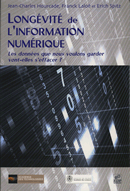 Questa domanda solleva un problema sempre più importante: la nostra società produce masse crescenti di informazioni, anche se la durata di vita media digitali permettono di memorizzare non è mai stato breve. Archiviazione o backup a breve termine, non solleva alcun problema particolare, ma cercare in questo modo nel corso di decenni o di un secolo pone un problema diverso, nel senso che i media digitali hanno una durata di 5 o 10 anni ". Questa domanda solleva un problema sempre più importante: la nostra società produce masse crescenti di informazioni, anche se la durata di vita media digitali permettono di memorizzare non è mai stato breve. Archiviazione o backup a breve termine, non solleva alcun problema particolare, ma cercare in questo modo nel corso di decenni o di un secolo pone un problema diverso, nel senso che i media digitali hanno una durata di 5 o 10 anni ".
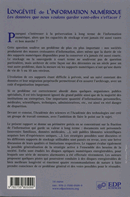 "L'evoluzione di questi materiali è difficile prevedere, solo un costante monitoraggio dei dati e la loro migrazione garantirà l'archiviazione perpetua, con un costo significativo per organizzare. "L'evoluzione di questi materiali è difficile prevedere, solo un costante monitoraggio dei dati e la loro migrazione garantirà l'archiviazione perpetua, con un costo significativo per organizzare.
Se questo problema sia adeguatamente affrontato in alcune agenzie specializzate, è largamente ignorato dal grande pubblico e la maggior parte delle istituzioni o imprese. Una quantità significativa di informazioni personali, mediche, scientifiche, tecniche, amministrative, ecc. È quindi in pericolo di estinzione ".
"Questo rapporto fornisce una limiti esatti, concentrandosi sulla frazione delle informazioni che mantiene il suo valore nel lungo periodo i giornali o le memorie familiare e personale (, dati medici, ...), sia i dati pubblici (scientifiche acquisite durante esperienze uniche, ... ). Possibili strategie vengono discusse e supporti di memoria utilizzati sono vari rivisto, con una breve discussione delle loro rispettive qualità e limiti. La relazione valuta anche la possibile diffusione della strategia attiva di tutti i bisogni della società. Infine studiate sono dischi digitali ottici, per i quali una serie di allarmanti è stata effettuata di recente. Gli autori propongono alcune piste che potrebbero portare a dischi registrabili longevità molto meglio e rilasciare quattro raccomandazioni suscettibili di essere a conoscenza di questo problema generale e sui possibili modi per risolverlo."
La mémoire numérique n'est pas immortelle, dit l'Académie
Article publié le 03 Avril 2010
Par Hervé Morin
Source : LE MONDE
Taille de l'article : 353 mots
Estratto:
Una relazione che indica il rischio di amnesia dovuto all'invecchiamento precoce dei supporti di dati digitali. I dati che vogliamo conservare scompariranno? "Questo è il sottotitolo di una relazione congiunta delle Accademie di Scienze e Tecnologie dal titolo" Longevità della Digital Information ", pubblicato Lunedi, 29 marzo. Un errore comune è che i dati digitali possono essere conservati a tempo indeterminato. Il rapporto sfata questa idea. I media digitali, sia hard disk, memorie flash, nastro magnetico o diverse generazioni di dischi ottici, hanno fatto progressi in termini di capacità di storage a breve termine.
 
The Phoenix DVD
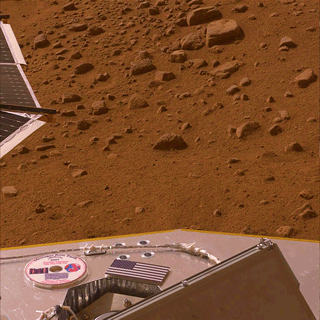 |
Visions of Mars, on Mars
This image shows the DVD provided by The Planetary Society to the
Phoenix mission, which contains 250,000 names of people who signed
up to send their names to Mars. It also contains "Visions
of Mars," messages to future Martian explorers, science
fiction stories and art inspired by the Red Planet. The DVD is
mounted on the deck of the lander, which sits about one meter
above the Martian surface, visible in the background. Credit:
NASA / JPL / U. Arizona |
THE PHOENIX HAS LANDED
Phoenix touched
down safely on the surface of Mars at 23:38 UTC (16:38 PDT). Follow
the mission at The Planetary Society's blog.
Phoenix Carries First Martian Library and 250,000 Names. Find
out more.
Did you send your name to Mars on Phoenix? You can still find
and print your participation certificate.
________________________________
After landing, the spacecraft's scientific instruments will come alive,
and begin their search for water ice in the harsh Martian environment.
Nestled among busy instruments, a small and very special DVD will wait
patiently for its turn. This unique DVD is made of silica glass, and
designed to last hundreds if not thousands of years into the future,
when its true mission will commence. It carries nothing less than a
message from our world to one centuries away, when humans will roam
the Red Planet.
In a unique project called Visions
of Mars, the Phoenix DVD carries personal messages from
visionaries of our own time to future visitors or settlers on Mars.
There is Carl
Sagan near his home in Ithaca, New York, addressing the
future Martians with a cascading water fall in the background.
There is Arthur
Clarke seated in the comfort of his home in tropical Sri
Lanka. There is Planetary Society Executive Director Louis
Friedman, speaking from Society headquarters in Pasadena,
and there is Phoenix mission PI, Peter Smith, providing
mission information and a greeting
to the future.
Others speak to the future not directly, but through their visionary
works, which shaped our imaginings of the Red Planet. A wealth
of influential pieces are included in Visions of Mars, which was
assembled and edited by Planetary Society advisor Jon
Lomberg. Percival Lowell, in beautiful poetic prose,
expounds his theory of the "Mars canals," and the intelligent
beings that built them. H.G. Wells, in War of the Worlds,
imagines what such desperate creatures might do to our own beloved
Earth. The recording of Orson Welles' 1938 radio broadcast
of this classic tale -- which set off a wave of panic across the
United States -- is also digitally encoded on the Phoenix DVD. Louis
Friedman contributed an afterword,
describing the origins and history of Visions
of Mars, and how it came to be.
Among those included in this remarkable message to the future are Isaac
Asimov, Ray Bradbury, Poul Anderson, a musical
production of Bob Derkach's "Winds of Mars," and
many others. A collection of rare
Mars artwork, reflecting our changing images of our neighboring
planet can also be found on the Phoenix DVD. All this, and much,
much more, from the visionaries of the past century, whose dreams
of Mars shaped our own.
Thousands of People will be there with Them.
Thousands of people from around the world, joined our age's visionaries
of space exploration by adding
their names to this remarkable message to the future! The Planetary
Society collected names, which are now on Mars on the Phoenix DVD.
When the Martians of the future find and decode our message to them,
their names will be there too, a permanent record of their part in
the story of space exploration.
 émission
du vendredi 30 janvier 2009 émission
du vendredi 30 janvier 2009
Selon le cabinet d’études Infotrends, le nombre total
d’images numériques enregistrées dans le monde
depuis que cette technologie existe atteignait l’an dernier les
180 milliards. Et il devrait bondir à 347 milliards d’ici
2012. Soit presque un doublement en quatre ans. Et il ne s’agit
là que des images. Il faut y rajouter le texte, le son et la
vidéo. Car aujourd’hui, tout est devenu numérique.
Même la télévision. Et bientôt la radio.
Cette conversion généralisée à la forme
issue de l’informatique a posé un problème important
aux organismes chargés de conserver la mémoire officielle
de l’activité humaine.
En quelques années, le métier des grandes bibliothèques
et autres banques d’images, de musique ou de films a radicalement
changé. Il ne s’agit plus de conserver du papier, des
pellicules, des disques en vinyle ou des bandes magnétiques
mais bien des « données ». C'est-à-dire des
suites de 0 et de 1. Comment stocker de telles informations immatérielles
? Bien sûr, l’industrie a créé des supports
bien matériels pour y graver la mémoire numérique.
Le plus populaire a été inventé il y a tout juste
30 ans, en 1979. Il s’agit du fameux disque compact audio, le
célèbre CD. Une petite galette de 12 cm de diamètre
pour 1,2 mm d’épaisseur qui a donné naissance au
DVD en 1995 et au Blu-Ray en 2006-2007. Soit une capacité de
stockage multipliée par près de 40 en moins de 30 ans.
Ce support ainsi que d’autres comme les disques durs ou les mémoires
flash servent aujourd’hui à archiver des quantités
astronomiques de données numériques produites dans le
monde entier. Mais pour combien de temps ?
Une question presque saugrenue tant les supports d’information
numériques semblent éternels… Et pourtant, fin
2007, un scientifique du CNRS, Franck Laloë, a tiré le
signal d’alarme dans le magazine Pour la Science puis
dans le journal Le Monde . La durée de vie des supports
numériques serait bien plus courte qu’on ne l’imaginait.
Pas plus de dix ans, selon lui. Comment les professionnels de l’archivage,
mais également le grand public, vont-ils pouvoir, dans ces conditions,
transmettre notre mémoire numérique aux générations
futures ?
Invités:
Arnaud Beaufort. Directeur général adjoint
de la BNF et directeur des services et des réseaux
Franck Laloë. Chercheur au CNRS, Président
du GIS-DON (Le pôle de recherche sur la conservation des données
sur disques optiques numériques)
Daniel Teruggi. Directeur du Groupe de Recherches
Musicales, le GRM, depuis 1997 et Directeur de la Recherche et de l’Expérimentation à l’INA
depuis 2001, ccordinateur du projet européen Prestoprime sur
la conservation des données numériques à très
long terme.
 
Phoenix DVD with 250,000 Names Ready to Launch to Mars
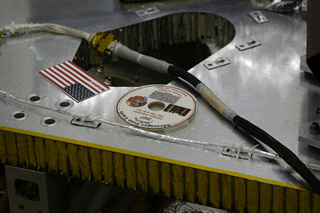 |
The Phoenix DVD
On April 3, 2007 at the Multipurpose Test Facility at the Lockheed
Martin Waterton Plant in Denver, Colorado, the Phoenix DVD was
installed on the deck of the Phoenix lander. Credit: NASA / JPL
/ Lockheed Martin |
May 23, 2007
As part of our Messages from Earth project, The Planetary Society
collected names to travel to Mars on board the Phoenix lander. I'm
happy to announce the silica glass mini-DVD with a quarter million
names on it (including all Planetary Society members) has been installed
on the Phoenix spacecraft and is ready to go to Mars!
In addition to the names, the disc also contains Visions of Mars,
a collection of literature and art about the Red Planet. The names
and Visions of Mars were written to the silica mini-DVD by the company
Plasmon OMS using a special technique. The resulting archival disk
should last at least hundreds of years on the Martian surface, ready
to be picked up by future explorers.
After the disc was written, a special label was applied to the disc
to identify it for future explorers. Then, the whole assembly was "baked
out" (to kill microbes and also to reduce future outgassing of the
materials), and Lockheed Martin in Colorado installed it onto the spacecraft.
After installation, the spacecraft underwent further testing and assembly,
was shipped to Cape Canaveral, and is now being prepared for its August
launch to Mars. Phoenix will arrive and land in the northern near-polar
regions on Mars in late May or early June 2008 (exact date depends
on actual launch date).
We'll keep you posted on the mission as it progresses towards launch,
and of course, update you on its launch and landing.
Next stop: Mars!
|